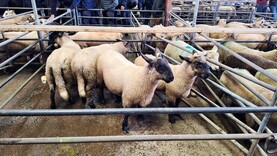This week’s publication of agricultural input and output prices for April shows that the gap between what farmers are getting paid for their produce and the costs they incur in the running of their enterprises is at the widest since the Central Statistics Office (CSO) starting producing this dataset in 2020.
As Figure 1 shows, increases in input prices (costs to farmers) and increases in output prices (income for farmers) generally moved in lockstep with each other until the middle of 2022. After that, there was an 18-month period where output prices fell faster than input prices, putting farm profitability under severe pressure.
That trend changed again in early 2024 with output prices rising again as costs stabilised. The widening gap between the two measures since then suggests that Irish agriculture was at its most profitable level in April since the start of this dataset.
Digging into the data published by the CSO we can see that the distribution of this profitability across the farming sector is far from even. Taking the last 12 months, we can see that output prices for cattle have increased by 50% between April 2024 and April 2025.
Milk prices were up by 23%, sheep prices rose by 11% while output prices for crops actually dropped by 5.5% (see Figure 2). This suggests that when we talk about increased farm profitability, we’re actually talking about increased profitability in the beef sector. Farmers producing crops have actually seen a reduction in profits as costs have dropped by less than 1% while prices have fallen by 5.5%.
On the costs side, livestock farmers are the biggest winners again as the largest drop in the main costs subindexes has been in feed, which is 5% lower than it was a year ago.
Energy prices are also lower than they were in April of last year.
The biggest concern has been the re-emergence of growth in fertiliser prices. While they are still far below the levels since at the height of the spike in the wake of the Russian invasion of Ukraine, they are 7.5% higher than a year ago and have increased by 20% in the first four months of this year alone (see Figure 3).
As highlighted on pages 11 and 28, there is nothing to suggest that there will be a reversal of this trend any time soon.
Comment
The latest data on farm costs and prices, taken as a whole, is good news for the industry. It’s been no secret that beef prices have been very strong for the last few months and the recovery in the dairy market has certainly been welcome. However, it is continued disappointing performance of the tillage sector which should be ringing alarm bells.
It is Government policy to increase the area under crops in the country. Since the introduction of the target for 400,000ha as part of the measures to reduce greenhouse gas emissions from agriculture, little substantial progress has been made on meeting that target. The biggest incentive for farmers to increase the production of crops has to be the possibility of making more money from the change. If tillage cannot be shown to be profitable – and existing farmers are finding themselves in competition for land against dairy, and even beef, farmers who are making more money from their operations, then there is little hope of sustainably increasing the area in the country under crops.
There will always be challenges in making money from farming and there will always be winners and losers between different sectors. Right now, beef is having its moment in the sun. But if Government policy is to favour one sector over others then an essential starting point has to be for farmers to see that sector as being financially sustainable over the medium term.






 This is a subscriber-only article
This is a subscriber-only article










SHARING OPTIONS: